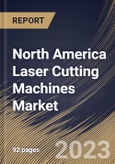The method of laser cutting is a form of thermal processing that involves the use of a focused beam of light to change the material in an intensely localized area. A co-axial burner is utilized to discharge the liquid material and create a kerf. An eternal cut is produced by manipulating the beam of light or piece of work under CNC control. There are three fundamental varieties of laser cutting: fusion, flame, and remote. Utilizing an inert gas (typically nitrogen), molten material is expelled from the kerf during infusion cutting. Nitrogen gas does not contribute to the energy input because it does not react exothermically with molten metal.
In flame cutting, oxygen is used as a support gas; this results in an exothermic reaction that boosts the energy input and mechanically stresses the molten material. A high-intensity laser beam partially vaporizes the material during remote cutting, enabling thin sheets to be sliced without using an assist gas. In addition, laser cutting is a technology used to cut materials like carbon dioxide, solid-state, and fiber. In addition, laser cutting machines can precisely cut various materials, including steel and plastic. It is a vital production tool utilized by consumer electronics, automotive, machine tooling, and other manufacturing industries to produce components with complex geometry.
A key pillar of the Mexican economy is the industrial sector. The industry, which accounts for 18.5% of the economy and 47.9% of the investment, is the main draw for FDI. Mexico has 14 free trade agreements with more than 46 countries and grants preferential access to various industries. About 80% of the nation's exports go to the US, an important trading partner. The region's industrial sector's strong presence and ongoing development are anticipated to increase the use of laser cutting technologies for production, driving the market's expansion in the region.
The US market dominated the North America Laser Cutting Machines Market by Country in 2022 and would continue to be a dominant market till 2029; thereby, achieving a market value of $1,954.1 million by 2029. The Canada market is poised to grow at a CAGR of 7% during (2023-2029). Additionally, The Mexico market would showcase a CAGR of 6% during (2023-2029).
Based on Application, the market is segmented into Industrial, Automotive, Consumer Electronics, Defense & Aerospace, and Others. Based on Technology, the market is Solid State Lasers, Gas Lasers, and Semiconductor Lasers. Based on Process, the market is Flame Cutting, Fusion Cutting, and Sublimation Cutting. Based on countries, the market is segmented into U.S., Mexico, Canada, and Rest of North America.
The market research report covers the analysis of key stake holders of the market. Key companies profiled in the report include AMADA CO., LTD., TRUMPF SE + Co. KG, FANUC Corporation, Bystronic Laser AG, Coherent Corp., IPG Photonics Corporation, Jenoptik AG, DPSS Lasers, Inc., Epilog Laser, and Kern Laser Systems.
Scope of the Study
By Application
- Industrial
- Automotive
- Consumer Electronics
- Defense & Aerospace
- Others
By Technology
- Solid State Lasers
- Gas Lasers
- Semiconductor Lasers
By Process
- Flame Cutting
- Fusion Cutting
- Sublimation Cutting
By Country
- US
- Canada
- Mexico
- Rest of North America
Key Market Players
List of Companies Profiled in the Report:
- AMADA CO., LTD.
- TRUMPF SE + Co. KG
- FANUC Corporation
- Bystronic Laser AG
- Coherent Corp.
- IPG Photonics Corporation
- Jenoptik AG
- DPSS Lasers, Inc.
- Epilog Laser
- Kern Laser Systems
Unique Offerings
- Exhaustive coverage
- The highest number of Market tables and figures
- Subscription-based model available
- Guaranteed best price
- Assured post sales research support with 10% customization free
Table of Contents
Companies Mentioned
- AMADA CO., LTD.
- TRUMPF SE + Co. KG
- FANUC Corporation
- Bystronic Laser AG
- Coherent Corp.
- IPG Photonics Corporation
- Jenoptik AG
- DPSS Lasers, Inc.
- Epilog Laser
- Kern Laser Systems
Methodology

LOADING...








